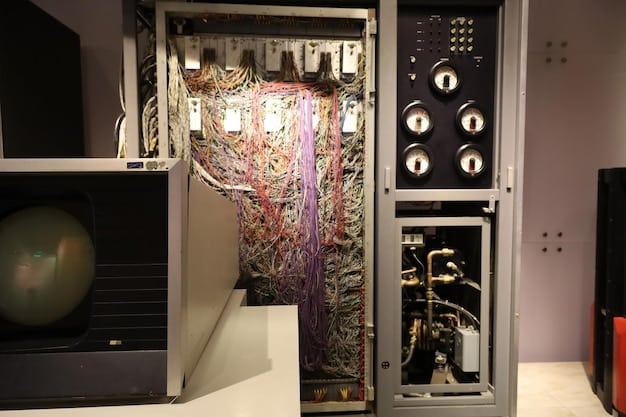The Truth About Extended Warranties: Are They Worth It in 2025?

Extended warranties for appliances in 2025 offer protection against unexpected repairs, but whether they’re worth the cost depends on factors like the appliance’s reliability, the warranty’s terms, and your risk tolerance and budget.
Are you considering an extended warranty for your new 2025 appliances? The promise of peace of mind can be tempting, but is it truly a worthwhile investment? Let’s explore the truth about extended warranties: are they worth it for 2025’s top appliances?
Understanding Extended Warranties for 2025 Appliances
Extended warranties, also known as service contracts, offer repair or replacement coverage beyond the manufacturer’s original warranty. With the increasing complexity of smart appliances in 2025, understanding these warranties is crucial.
They’re essentially insurance policies against potential breakdowns. But are they a necessary expense, or a marketing tactic designed to generate profit for retailers?
What Do Extended Warranties Cover?
Extended warranties typically cover mechanical and electrical failures resulting from normal use. However, the specifics can vary significantly.
- Parts and Labor: A good warranty covers both the cost of replacement parts and the labor needed to install them.
- Repair or Replacement: Some warranties offer repair services, while others provide for a full replacement if the appliance cannot be fixed.
- Specific Components: It’s important to check which components are covered, as some warranties may exclude certain parts.
What’s Typically Excluded?
Understanding what an extended warranty doesn’t cover is just as important as knowing what it does.
- Accidental Damage: Most extended warranties don’t cover damage caused by accidents, misuse, or neglect.
- Cosmetic Issues: Scratches, dents, and other cosmetic issues are usually not covered.
- Routine Maintenance: Regular maintenance tasks, such as cleaning or filter replacement, are typically the owner’s responsibility.

Ultimately, understanding the scope and limitations of an extended warranty is essential before making a decision. Carefully review the terms and conditions to avoid surprises later on.
Assessing the Reliability of 2025’s Top Appliances
Before purchasing an extended warranty, consider the inherent reliability of the appliance itself. Some brands and models have a better track record than others.
Researching the reliability of the specific appliance you’re buying can help you make an informed decision about whether or not an extended warranty is necessary.
Researching Appliance Brands and Models
Start by researching the reliability ratings of different appliance brands and models. Consumer Reports and other independent review sites often publish reliability surveys.
Consider factors such as the frequency of repairs, the cost of repairs, and the overall satisfaction of owners.
Considering the Complexity of Smart Appliances
Many of 2025’s top appliances are equipped with sophisticated smart technology. While these features can be convenient, they also add complexity, which can increase the risk of failure.
- Software Glitches: Smart appliances rely on software, which can be prone to glitches and bugs.
- Connectivity Issues: Connectivity problems can disrupt the functionality of smart features.
- Electronic Components: Smart appliances have more electronic components than traditional appliances, increasing the potential for failure.
When considering an extended warranty for a smart appliance, factor in the added complexity and potential for technological issues.
In summary, assessing the reliability of appliances involves researching brands and considering the impact of smart technology, allowing informed decisions about extended warranties.
Evaluating the Cost of Extended Warranties vs. Potential Repair Expenses
A key factor in deciding whether to purchase an extended warranty is weighing the cost of the warranty against the potential cost of repairs. Is the upfront expense worth the potential savings down the road?
Consider the likelihood of needing repairs and the potential cost of those repairs.
Comparing Warranty Costs to Repair Costs
Obtain quotes for extended warranties from multiple providers and compare them to the estimated cost of potential repairs. Research the average repair costs for the type of appliance you’re buying.
Factor in the deductible, if any, and any limitations on the warranty coverage.
Calculating the Break-Even Point
Determine the “break-even point,” or the amount of repair costs that would need to be covered by the warranty to justify its purchase. If the cost of the warranty is close to the potential repair costs, it may be worth considering.
However, if the cost of the warranty is significantly higher than the potential repair costs, it may be more cost-effective to self-insure by setting aside money for potential repairs.

Evaluating the cost of extended warranties against potential repair expenses requires a careful assessment of both upfront costs and potential savings. Consider the likelihood of needing repairs and the potential expense involved.
Reading the Fine Print: Key Terms and Conditions to Consider
The devil is often in the details, and extended warranties are no exception. Before purchasing a warranty, carefully review the terms and conditions to understand the coverage, limitations, and exclusions.
Pay close attention to the fine print to avoid surprises later on.
Coverage Details
- What’s Covered: Make sure you understand exactly what components and types of failures are covered by the warranty.
- Coverage Period: Know the length of the coverage period and the start and end dates.
- Deductibles: Be aware of any deductibles or service fees that you’ll be responsible for paying.
Limitations and Exclusions
- Exclusions: Pay close attention to any exclusions, such as accidental damage, misuse, or cosmetic issues.
- Limitations: Be aware of any limitations on the number of claims or the total amount of coverage.
- Geographic Restrictions: Some warranties may only be valid in certain geographic areas.
Claim Procedures
- How to File a Claim: Understand the steps involved in filing a claim and the documentation required.
- Service Providers: Check whether you’re required to use specific service providers or if you can choose your own.
Carefully review the fine print of extended warranties to avoid surprises related to coverage, limitations and exclusions, and claim procedures.
Alternatives to Extended Warranties: Self-Insurance and Credit Card Benefits
Extended warranties aren’t the only option for protecting yourself against appliance repair costs. Consider alternatives such as self-insurance and credit card benefits.
These options may provide similar coverage at a lower cost, offering flexibility and potential savings.
Self-Insurance
Self-insurance involves setting aside money in a savings account to cover potential repair costs. This approach gives you greater control over your funds.
You can use the money for any repairs, regardless of whether they would be covered by an extended warranty.
Credit Card Benefits
Some credit cards offer extended warranty protection as a benefit. This coverage may extend the manufacturer’s warranty by a year or more.
Check the terms and conditions of your credit card to see if this benefit is available and what it covers.
Alternatives to extended warranties include self-insurance and credit card benefits, providing flexibility and potential savings for appliance repairs.
Making the Right Decision: Factors to Consider Before Buying
Deciding whether to purchase an extended warranty is a personal decision that depends on your individual circumstances, including tolerance for risk, the appliance’s features, and financial preparedness.
Carefully weigh the pros and cons of extended warranties before making a decision.
Your Risk Tolerance
How comfortable are you with the risk of unexpected repair costs? If you’re risk-averse, an extended warranty may provide peace of mind.
However, if you’re comfortable with taking on some risk, you may be better off self-insuring.
The Appliance’s Features and Cost
Consider the features and cost of the appliance. Higher-end appliances with advanced features may be more prone to failure, making an extended warranty more worthwhile.
For less expensive appliances, the cost of an extended warranty may not be justified.
Your Financial Situation
Assess your financial situation and determine whether you can afford the cost of an extended warranty. If you’re on a tight budget, an extended warranty may not be a wise investment.
Making the right decision about extended warranties requires careful consideration of risk tolerance, appliance features and cost, and financial situation.
| Key Point | Brief Description |
|---|---|
| 💰 Cost vs. Benefit | Evaluate if warranty cost justifies potential repair savings. |
| 🔍 Read the Fine Print | Understand coverage limits and exclusions. |
| ⚙️ Appliance Reliability | Research brand and model reliability. |
| 🛡️ Alternatives | Consider self-insurance or credit card benefits. |
Frequently Asked Questions
▼
An extended warranty, also known as a service contract, provides repair or replacement coverage beyond the manufacturer’s original warranty, acting as an insurance against potential breakdowns.
▼
Extended warranties generally cover mechanical and electrical failures resulting from normal use, including parts and labor needed for repairs or replacements, though specifics vary greatly.
▼
Research brand and model reliability through sources consumer reports, factoring in aspects like repair frequency, costs, and user satisfaction to gauge potential issues.
▼
Consider setting aside money for repairs, known as self-insurance, or utilizing credit card benefits that offer extended warranty protection, potentially providing savings and greater flexibility.
▼
Assess your risk tolerance, the appliance’s features and their costs, and your financial situation to make an informed decision about purchasing an extended warranty.
Conclusion
In conclusion, extended warranties for 2025’s appliances entail carefully weighing options against product reliability, costs, benefits, personal risk tolerance, and finances, necessitating thorough evaluation and comprehension for informed choices.





![Is the updated [product] truly better? A deep dive into enhancements Is the updated [product] truly better? A deep dive into enhancements - Cover Image](https://youforyous.com/wp-content/uploads/2025/07/youforyous.com_4_1753831175_a20b5125_cover-360x180.jpg)